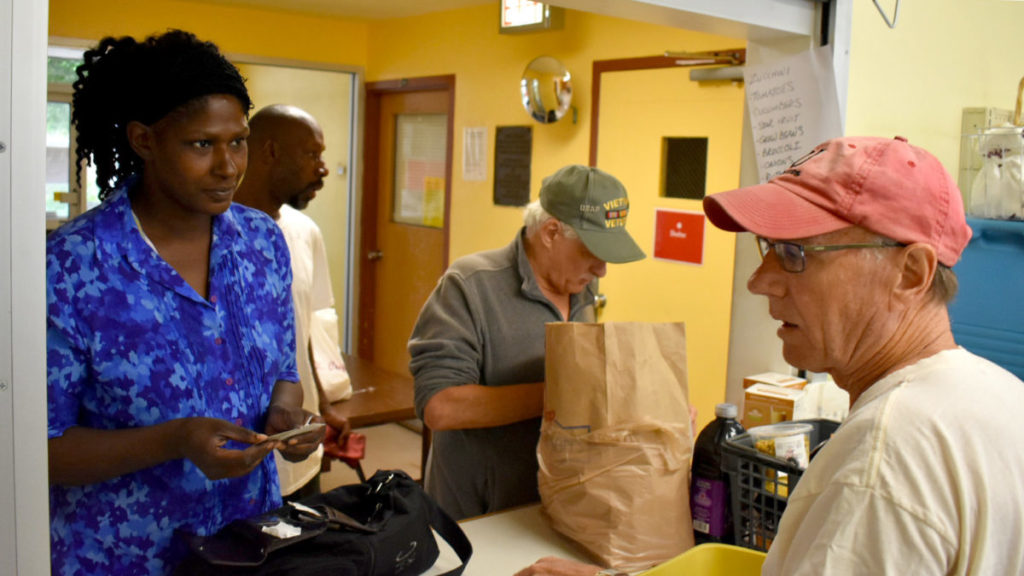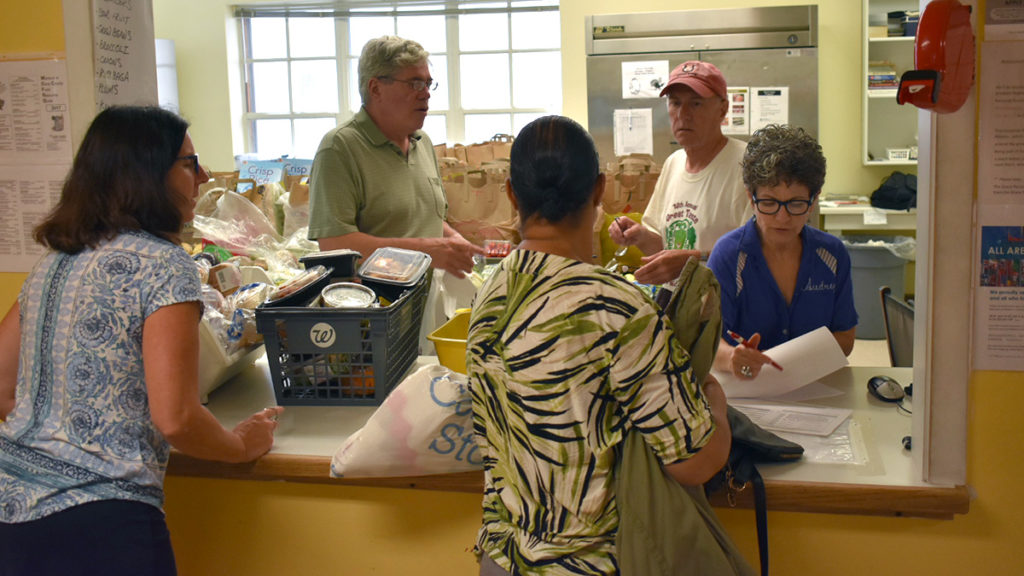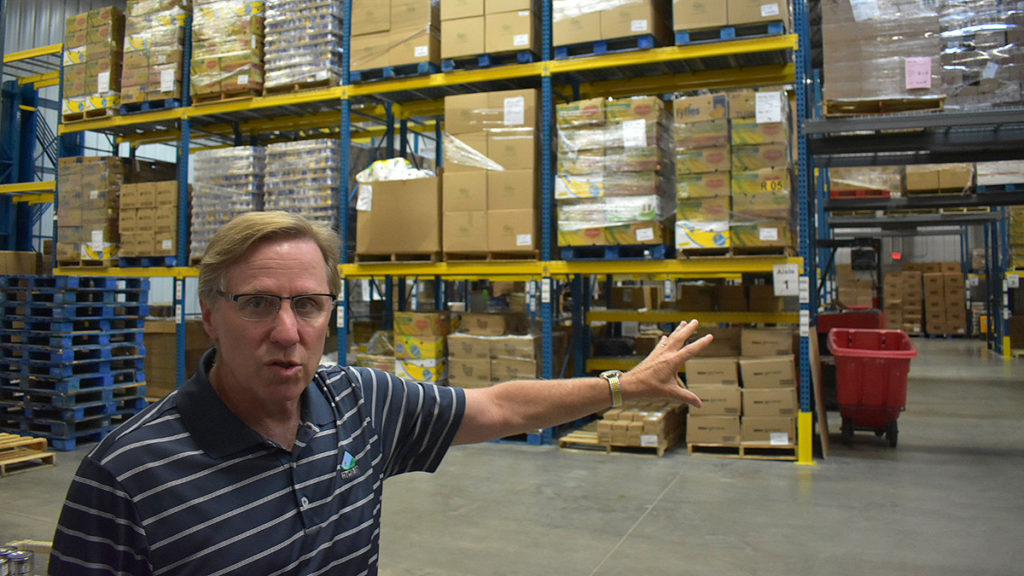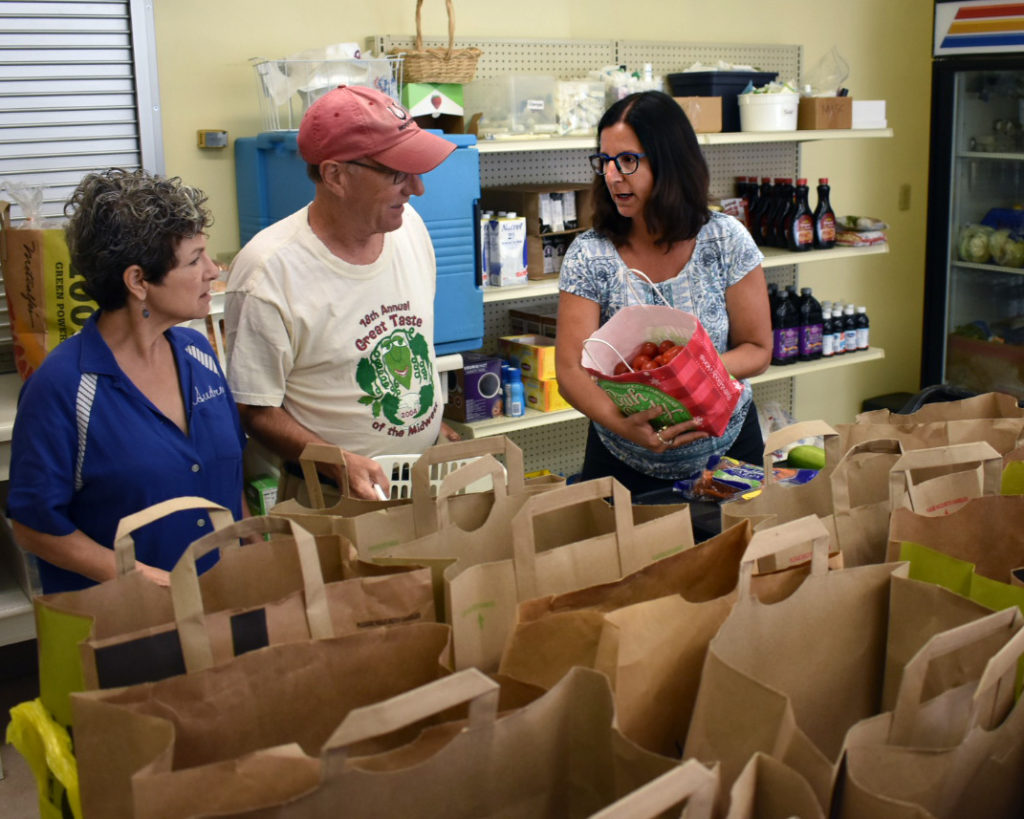Episcopal food pantries are part of nationwide network with goal of ending hunger in US

Poverty and hunger are all too easy to overlook in Wisconsin’s capital city, where public discourse is dominated by the parallel and relatively affluent spheres of state government and the state’s flagship public university.
But wander east from the University of Wisconsin-Madison campus or head southwest down the steps of the Capitol, and you’ll find at Grace Episcopal Church a ministry of nourishment that Willetta Randle, for one, relies on to put dinner on the table for her two young children.
The volunteers at Grace Food Pantry are friendly and helpful, Randle said while picking up bags of food on a summer afternoon. She visits “once in a while,” when she needs help filling her cabinets and refrigerator with food. “It comes in handy, especially when you’re on a tight budget,” she said.
‘Food and Faith’
Episcopal News Service’s five-part series focuses on anti-hunger efforts in the Episcopal Church, from food pantries to the church’s advocacy on government programs that fight hunger. Part 3 will post next week.
Despite the city’s median household income of $55,000, tight budgets are common in Madison. Census data show 19 percent of residents live below the poverty level, and dozens of food pantries across Dane County help provide for some of their most basic needs. Many of the pantries are part of a national network of faith-based and community partners with a shared goal: to make sure no one goes hungry – in the country, in Wisconsin, in Madison or in the neighborhood around Capitol Square that Grace Episcopal calls home.
The parish food pantry is an institution as ubiquitous as it is essential. Congregations across the country feed the hungry through pantries of all sizes, making this one of the most common and visible outreach ministries of the Episcopal Church and other churches and faith communities in the United States.
“The way the Episcopal Church wants to approach people in our country who are poor is not … with a sense of helping those who are other than us,” said the Rev. Melanie Mullen, the Episcopal Church’s director of reconciliation, justice and creation care. Building “a full community of change” means seeing our neighbors as like us – and, sometimes, in need of help, she said.
“We can have confidence to enter this arena boldly and talk about what’s right and what’s wrong and the fact that no one should be hungry among us.”
Congregations’ food ministries, no matter the denomination, are on the front lines of a multilayered response to food insecurity in America. The federal government defines food insecurity as lack of access to enough food to maintain an active and healthy life. Nationally, 41.2 million people, including 12.9 million children, were said to be food insecure in 2016, according to the nonprofit Feeding America.
Episcopal News Service, as part of its “Food and Faith” series on the Episcopal Church’s efforts to fight hunger, visited Madison’s Grace Episcopal Church in August to see how one successful food pantry works and how it collaborates with other institutions working on the issue at all levels.
Feeding America works at the national level to support its 200 affiliated regional food banks, which form the backbone of local efforts. Those affiliates, like Second Harvest Foodbank of Southern Wisconsin, collect large amounts of food and distribute it to where it is most needed.
Often where it is most needed is a food pantry like the one at Grace Episcopal Church in Madison.

Nearly 58,000 of the 510,000 residents of the city and surrounding Dane County, or 11.3 percent, are food insecure, according to the most recent data kept by Feeding America. Grace Food Pantry was created in 1979 to serve those residents, and now 38 years later, it operates as an independent nonprofit with a paid coordinator.
The Episcopal Church’s Asset Map, which is still under development, shows more than 300 congregations offering food pantries, meal programs or both. Since the map’s participation rate so far is at about 20 percent, the actual number of feeding ministries likely is exponentially greater.
Their sizes range widely. Grace Food Pantry is among the more active ministries, open four days a week and serving 450 to 950 people a month. In a typical month, about 10,000 pounds of food is distributed. The pantry gets by on a $22,000 annual budget that still is largely funded by the congregation.
“It’s been a core part of our work and our ministry, and it receives a lot of financial support from the members of the church,” the Rev. Jonathan Grieser, Grace’s rector, said during an interview in his office. “It’s part of the gospel mission to feed the hungry.”
The fruits (and vegetables) of that gospel mission awaited Randle, 35, and the handful of other guests who were first in line when the food pantry opened at 1 p.m. on this Tuesday in August. A handwritten list was stuck to a wall next to the counter: zucchini, tomatoes, cucumbers, star fruit, green beans, broccoli, onions, rutabaga, plumbs, kiwi, peaches, cauliflower.
That was only a partial list. Each guest who meets income qualifications can get a weekly allotment of food in amounts that vary with the size of the household. Randle received some eggs along with her produce. Meat also is included, and the variety of food can change week to week.
“You don’t get the same thing all the time,” Raymond Scott, a 67-year-old Air Force veteran, said as he waited his turn, his suitcase ready to be filled with food from the pantry.
Food banks aim to let no one go hungry
The source for much of the pantry’s food is a large warehouse seven miles away in the southeast corner of Madison.
Second Harvest’s facility on Dairy Drive boasts some impressive numbers. At 47,000 square feet, the warehouse houses offices, sorting and packing rooms, three coolers, several loading docks and row after row of stock shelves that typically hold about 1 million pounds of food, with a capacity for up to 1.7 million pounds.
Hundreds of volunteers contribute their time to Second Harvest each month, and a staff of eight drivers steer the agency’s six semi-tractor trailer trucks and three straight trucks across 16 counties in southwest Wisconsin, delivering enough food in 2016 for 14.3 million meals.

Second Harvest’s general model for feeding the hungry is hardly unique. Feeding America assigns Second Harvest and other member food banks to serve distinct regions that include every county in the United States without overlapping. The food banks collect food and distribute it across their regions, over and over. Often the Feeding America affiliate is the only food bank serving its communities, though some regions are served by additional food banks that aren’t affiliated with Feeding America.
As they feed the hungry, these agencies also function like laboratories for new anti-hunger initiatives.

“There’s no magic formula how to run your food bank. Everyone offers different programs and different ways to attack this problem,” Second Harvest Executive Director Dan Stein said during an interview at the Madison warehouse. “We all are each other’s best cheerleaders. We freely share each other’s best practices. We share things that were unsuccessful, so we don’t waste resources.”
Stein’s agency, for example, has found success working directly with farmers to grow crops that can be distributed by Second Harvest’s partner food pantries. In addition, Second Harvest sends its trucks more than 20 times a month to distribute food to people in places not already served by food pantries. It also has developed partnerships with health care providers and schools to promote nutrition.
Pantries like the one at Grace Episcopal, though, are still the indispensable “feet on the streets” in the communities Second Harvest serves, Stein said. They know their clients’ needs.
The pantries can place orders online, paying Second Harvest a fee for the food. Certain items are offered to the pantries at a reduced rate or for free. Then the food bank’s transportation supervisor dispatches drivers to make the requested deliveries.
Being part of a large network also offers economies of scale. Nationally, Feeding America solicits large corporate donations and develops relationships with national retailers, like Walmart, Kroger and Target, to donate their excess food to the regional food banks. Feeding America also is active on public policy, supporting federal programs that help feed low-income Americans, such the program commonly known as food stamps. The Episcopal Church shares those concerns and advocates for those programs through its Office of Government Relations.
Feeding America traces the organization’s history to what it credits as the first food pantry, started in 1967 by a Roman Catholic church in Phoenix, Arizona. In a domino effect, churches around the country began forming their own pantries, and in 1979, the national organization was created to leverage the coordinated work of member pantries. Many, but not all, of the food pantries run by Episcopal churches are affiliated with Feeding America.
“Solve hunger” is the mantra of today’s Feeding America, but that bold goal is also a practical one. For Feeding America, solving the problem means making sure no one goes hungry. The root causes of poverty are more complex. Solving poverty is not the organization’s specific mission, though it and other organizations, including the Episcopal Church, are tackling various aspects of the problem.
“I can think of nothing better than a society where we have a hunger-free America,” Catherine Davis, Feeding America’s chief marketing and communication officer, said in a phone interview with ENS. “And that’s actually our mission, to help create a hunger-free America. But the majority of our work goes to feeding people.”
That work continues seemingly without end. Hunger is better understood as a chronic social problem rather than a sudden individual emergency, Davis said. There always will be people seeking food assistance who are driven by unforeseen circumstances – a lost job, a car repair, a medical bill. At the same time, most of the people who visit food pantries have steady jobs. Those jobs just don’t pay enough to make ends meet.

“If the cure for hunger is food – I know it’s not that simple – then the cure exists,” Stein said, “because as much as 40 percent of the food grown in this county never makes it to our tables. It’s thrown away.” Getting food to those who need it, then, becomes a logistical and financial challenge.
Curing poverty is a more complex challenge, he said, and other organizations are working on different facets of the problem. Helping people find good-paying jobs is “the best battle against hunger and poverty,” Stein said, while food banks’ primary focus is eliminating the gap between the meals Americans have and the meals they need.
At Grace Episcopal, food and blessings to share
Eliminating that gap in Madison depends on the dedication of people like Vikki Enright, the Grace Food Pantry coordinator.
Enright had previously volunteered with the food pantry and with Porchlight, a homeless shelter that occupies the floor below the pantry. After leaving her job as a senior legislative editor for the state’s Legislative Reference Bureau, she embraced the new paid role as pantry coordinator.
Enright’s $13,000 salary is paid directly by the congregation, leaving the pantry to spend its $22,000 budget on food from Second Harvest, additional food from other sources and personal essentials. Enright also draws on the pantry budget to pay her assistant, who works six hours a week.
As coordinator, Enright works 16 hours a week placing orders with Second Harvest, soliciting additional food donations from parishioners, downtown retailers and restaurants, scheduling about 30 volunteers to bag and distribute the food and ensure the shelves are continuously stocked with both food and personal items, like toilet paper – “it’s almost as important as food,” she said.

Last year, the pantry served more than 9,500 guests. The homeless population around Capitol Square makes up a portion of those guests, though others flock to Grace Food Pantry because it is a convenient stop on the city bus lines.
Randle, a nurse who lives with her children on Madison’s north side, brought her food home by bus this Tuesday afternoon. Caroline Harris said she, too, rides the bus to Grace Food Pantry when she needs to fill up her cart with produce.
“They give you mostly what you need,” Harris said. At age 55, she is out of work due to her severe arthritis, but she likes to prepare nutritious meals when her grandchildren come to visit. She said she typically only visits Grace Food Pantry a couple times a month because she’d prefer to share the blessings Enright’s team has to offer.
“I don’t like to overdo it, because I don’t like to take blessings from other people,” she said.
More people used Grace Food Pantry during the last recession, several years ago, Enright said. Visits declined as the local economy improved, but recently, she has noticed an increase in visitors as wages have stalled and rents have gone up.
Whatever her guests’ reasons for seeking help, Enright greets them with a smile and a friendly word as she tends to the work of the pantry with a seemingly boundless energy. The work keeps her perpetually upbeat.
“Every time something is frustrating or you’ve had a hard day with something, then something wonderful happens,” she said.
– David Paulsen is an editor and reporter for the Episcopal News Service.

